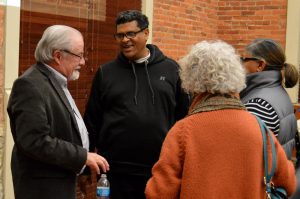New generations keep tales of the local Underground Railroad alive
Jessi LaRue — May 4, 2016

Larry McCellan speaking during the “Runaway Slaves in Northern Illinois” event.
Within DeKalb County lies an abundance of stories relating to the Underground Railroad.
When runaway slaves, also known as freedom seekers, traveled north in the 1800s, they could find wagons to travel in, or barns to stay in, once they reached northern towns like Sycamore and Somonauk.
It is believed that 2,600 to 4,000 freedom seekers passed through northern Illinois in the time leading up to the Civil War.
And as the years have gone by, those stories have not been forgotten. In fact, says Michelle Donahoe, people are seeking to learn even more about those stories.
Donahoe, Sycamore History Museum executive director, said the community’s fascination with local history and the Underground Railroad was what prompted the group to host Dr. Larry McClellan to discuss “Freedom Seekers and the Underground Railroad in Northern Illinois” last week.
The program was sponsored by the Mary E. Stevens Concert and Lecture fund.
The museum has hosted discussions on similar topics and had always drawn interest from the community. Last week’s event hosted a standing-room only audience in the DeKalb County Community Foundation’s Freight Room in Sycamore.
“[The Underground Railroad] is a story of national significance that also has a local connection,” Donahoe said. “It’s interesting because it really happened here. People stayed in these houses and walked these streets.”
McClellan, a retired professor from Governors State University, has published multiple writings on African American and regional history south of Chicago.
He has recently completed a book with co-author Kimberly Simmons, titled “To The River: Caroline Quarlls, Freedom Seeker on the Underground Railroad,” which will be published this fall.
His talk offered information on what was happening at national, state and local levels from the 1820s until the beginning of the Civil War. He also told stories of prominent freedom seekers, and the paths they took on their way to freedom, many of which took people onward to Canada. McClellan said most fugitive slaves “had to leave the land of the free to be completely free.”
He detailed the village of Somonauk’s involvement, especially the Somonauk United Presbyterian Church, during this time period.
The church was a stop on the Underground Railroad on the way to Canada.
McClellan said during the 1840s a group of about 300 people gathered at the Somonauk church and put together a proclamation which essentially said slavery was “against the laws of God and against the laws of love.”
“It was almost a near riot,” McClellan said. “They were excited to take a stand against this crazy law.”
McClellan also dispelled some myths about the Underground Railroad.
He said there is lots of good, detailed documentation about wagons being used to transport freedom seekers, but secret tunnels and things of that nature weren’t necessary in northern Illinois, where “everybody knew what was going on, and everybody knew who was on what side.”
“I would be relatively cautious about stories of these hidden rooms and things in houses,” McClellan said. “These stories don’t begin to pop up until years later.”
For more information on the Sycamore History Museum, visit SycamoreHistory.org.







